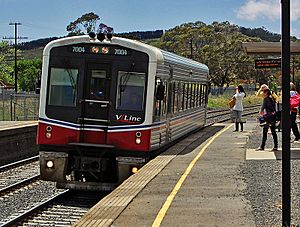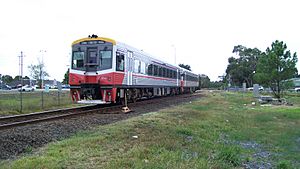V/Line Sprinter facts for kids
Quick facts for kids V/Line Sprinter |
|
|---|---|
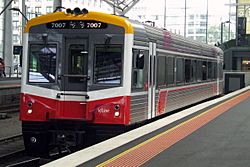
Refurbished 7007 at Southern Cross in
September 2007 |
|
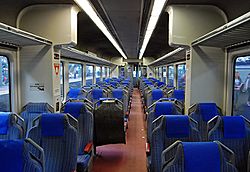
Interior pre-refurbishment
|
|
| Manufacturer | A Goninan & Co |
| Built at | Broadmeadow |
| Constructed | 1993-1995 |
| Entered service | December 1993 |
| Number built | 22 |
| Number in service | 21 |
| Number scrapped | 1 |
| Fleet numbers | 7001-7022 |
| Capacity | 90 |
| Operator(s) | V/Line, Metro Trains Melbourne |
| Depot(s) | Southern Cross |
| Line(s) served | Ballarat (Up to Bacchus Marsh) Geelong Gippsland North-East Stony Point |
| Specifications | |
| Car length | 25.9 m (85 ft 0 in) |
| Width | 2.92 m (9 ft 7 in) |
| Doors | 4 plug doors |
| Maximum speed | 130 km/h (81 mph) |
| Weight | 51 t (50 long tons; 56 short tons) |
| Prime mover(s) | 2 × Deutz BF8L513C |
| Power output | 470 kW (630 hp) |
| Transmission | Voith T211RZ hydraulic |
| Braking system(s) | Davies and Metcalfe EBC/5 EP pneumatic disc |
| Coupling system | Scharfenberg coupler |
| Track gauge | 1,600 mm (5 ft 3 in) |
The Sprinter is a diesel railcar built by A Goninan & Co, Broadmeadow for V/Line between 1993 and 1995.
Design origins
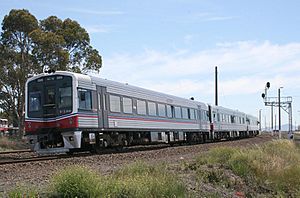
The Sprinter concept dates back to 1989, when the Public Transport Corporation, having seen a substantial increase in patronage and reduction in costs following the introduction of faster, more frequent services as part of the New Deal for Country Passengers program of the 1980s, required additional train capacity to meet demand. Initial talks suggested an order for 24 new vehicles, though the tenders for the construction of the 22 railcars closed in November 1989.
At the time they were designed to supplement locomotive-hauled H type carriage sets on shorter runs (such as on the outer suburban Melton and Sunbury lines, as well as the interurban Geelong and Seymour lines) and thus provide faster and more frequent service to Melbourne's fringe areas, and indirectly (primarily by freeing up other rollingstock) to more distant regions. Their introduction also enabled the retirement of the four DRC railcars from service.
In keeping with their intended operation, they feature high-capacity single-class seating and a single-car railmotor design over a multiple unit design, allowing a large number of passengers to be carried with greatly reduced operating costs and increased flexibility.
Manufacturing & testing
On 11 October 1991, the Federal Government announced the purchase of 22 Sprinters, built at a total cost of $65 million, of which the Federal Government provided $24 million through its Better Cities program.
Twenty-two single-car stainless-steel-body railcars were ordered from A Goninan & Co, Broadmeadow, for introduction to service between 1993 and 1995. Construction commenced in March 1993 with the final unit outshopped in January 1995. The first two units were fully fitted out at Goninan, with the other 20 units internally fitted out at the PTC North Bendigo workshops. All were transferred to Melbourne by rail on standard gauge transfer bogies.
Passenger experience
Sprinters feature a mix of 3x2 and 2x2 economy seats arranged so that half of them face the direction of travel at any one time. Reflecting the nature of the sets and their intended use, these seats are slightly smaller than the seats found in H and N sets and VLocity DMUs. They are finished in blue patterned cloth.
The cars are also fitted with a toilet and drinking fountains. Provision is made at one end of each carriage for one wheelchair and occupant. When this space is not needed able-bodied passengers may make use of the three wall-mounted fold-down seats. The toilet has a wide door and grab bars for use by disabled passengers.
While the capacity exists for several units to be coupled in service, passengers may not under normal circumstances move between coupled cars. A door is however provided, along with a detraining ladder, at the end of each car in case emergency egress is required. Conductors may move between cars during travel.
Passenger luggage can be carried in the overhead racks, between the backs of seats, or in the luggage/bicycle storage area usually found at the Melbourne end of the carriage. Ordinary access to the car is via four automatic plug doors, one on each side of the car at each end. These doors are opened by a push button mounted beside them and closed by the driver, and are wide enough to permit the access of a standard wheelchair.
Technical
Each car is powered by two air-cooled Deutz turbocharged V8 diesel engines. Power is transferred via a Voith T211RZ hydraulic transmission. Sprinters use a Davies and Metcalfe EBC/5 EP anti-slide pneumatic disc brake system.
To facilitate use in multiple-unit formations, they are fitted with Scharfenberg couplers. This allows them to be coupled to other Sprinters to form a train as long as eight carriages.
Service
Sprinter operation commenced in December 1993, with an official launch on the Ballarat corridor on 16 December 1993, with a special service running to Ballarat station and back, with the then Transport Minister, Alan Brown and other guests on board. A maximum speed of 143 km/h was achieved during this trip. They were launched on the Bendigo corridor on 17 March 1994, with a special service running to Bendigo station and back. The Sprinters were launched on the Geelong line on 1 September 1994, with a special service running to Geelong station, launching on the Seymour line on 14 December 1994, with a special service running to Seymour station, and finally launching on the Traralgon line on 16 June 1995, to coincide with the newly built Traralgon station.
For operation on the longer routes a portable buffet cart was trialled - the first such service since 1961, on the Horsham and Warrnambool lines. The cart was delivered to V/Line Passenger at Spencer Street Station on 12 August 1996, and its first use was on the 10:30am Melbourne to Bendigo and 1:20pm return service on the 15th of that month. By September 1996 the cart was in regular use between Seymour and Wodonga.
Over time, the Sprinters also operated to interurban destinations such as Warragul and Kyneton, along with outer suburban destinations like Craigieburn and Sunbury.
Sprinters were the first Victorian passenger trains to run at 130 km/h, and enabled acceleration of some services by up to 15 minutes. Furthermore, their relatively low operating costs allowed for an increase in service frequency on the Ballarat and Bendigo lines. These improved services contributed to an increase in V/line patronage from 6.5 million passenger journeys in 1993/94 to 7.0 million in 1995/96.
In addition, they performed some longer trips to destinations such as Albury and Echuca, although this was not specially catered for in their designs and thus led to some concerns over amenities such as lack of catering.
Following the introduction of VLocity stock, Sprinters have been returned to short-haul duties. Since 2008 a pair have been hired to Metro Trains Melbourne to operate services on the Stony Point line with units periodically rotated.
Sprinters are used on lines including:
- North-East line to Seymour
- Gippsland line to Traralgon
- Geelong line to Geelong
- Stony Point line between Frankston and Stony Point, leased to and operated by Metro Trains Melbourne
The Sprinters were specifically designed to also run on the South Gippsland line to Leongatha and still includes the town on its list of V/Line routes. Although they never ran this service, these trains were tested along the line from Dandenong to Cranbourne for a short period of time after the V/Line rail service to Leongatha was withdrawn on July 24, 1993.
When operating on the Stony Point line the toilet and drinking fountain are locked out of use.


